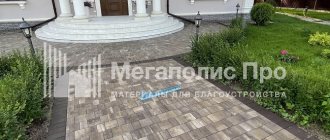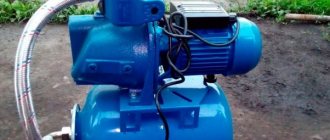Thanks to the abundance of available construction information on the World Wide Web, many believe that installing drainage from pitched roofs is a fairly simple task: install hooks, hang gutters and correctly continue the system to the foundation. But in fact, you still need to be able to drain water from the roof technically correctly. And then neither destroyed drains in the winter, nor sagging gutters in the hot summer, nor a damp and wet attic are scary.
Not to mention, the gutter system significantly impacts the home's exterior. These are those important details that are not always shown in the visualization of a house project, but which, ultimately, serve as its finishing touch, capable of either perfectly fitting into the designer’s or architect’s idea or hopelessly ruining the entire appearance. Therefore, let's approach this issue with all responsibility!
Methods for draining water from the roof of a country house
The main goal that is pursued when organizing drainage for a country house is to drain water in such a way that walls and blind areas do not flood and puddles do not form on the site. A gutter for a dacha is chosen based on the structural features of the roof, aesthetic preferences and financial capabilities. There are three main ways to drain water
:
- organization of water drainage using pipes and gutters
; - using a chain
instead of a pipe to drain water;
Non-standard solution for drainage Source muratordom.com.ua
- use of overhead gutters
on the roof eaves.
The most widespread method of draining water is using pipes and gutters. Let's take a closer look at its features.
Roof mounting technology
Involves installing gutters on brackets:
- to the rafters;
- on the front board;
- to the edge of the roofing material;
- using additional brackets.
Let us examine in what cases it is advisable to use different types of installation.
To the rafters
Fixing the drainage to the rafters is carried out when the sheathing has already been covered with roofing material, but it is also allowed before laying corrugated sheets, slate and various soft flooring.
The fastening element is brackets with a long leg bent at a right angle.
When the roof is covered, you will have to tear off or unscrew the last row, if it is slate or metal tiles, in order to secure the drainage system to the last row of the sheathing, the rafters. When using soft tiles or ondulin, simply lift the last row to tighten the bracket.
This method is used if the cross-section of wooden rafters is from 180*50 mm.
When fastening, the roofing material must cover the gutters.
On the front board
The front board is mounted at the ends of the rafters. Width may vary.
Fastening is carried out with long brackets or hooks made of a guide metal profile and a bracket.
Special long planks with a groove are also produced. The plank is screwed to the board with self-tapping screws, and brackets fit into the grooves.
To the edge of the roof covering
In this way, the drainage system runs along the eaves of the roof. Used when a rigid material such as corrugated sheeting has been selected for the flooring.
To fasten the brackets (plastic or metal), you will need special clamps.
There are times when you cannot do without holes in the roof. Then it is recommended to put rubber gaskets under the metal clamps (if any). This way there will be less chance of damage to the roof.
Using an additional bracket
Installation is carried out when the roofing is completed. The risk of material damage is minimized. Also, additional brackets will be required if the main brackets for fastening the gutters are short.
Take a long bracket and simply bend it to the required length, fix it with a self-tapping screw to the wooden sheathing.
It is important to maintain the required distance from the center of the holder to the edge of the overhang. The recommended value is 30–40 mm. This will allow water from the roof to flow into the center of the gutter. Otherwise, water will overflow over the edges.
Types of drainage systems
There are a huge number of options for drainage systems, which differ in size, material from which they are made and the manufacturer. The choice of one option or another depends on financial capabilities. Let's look at the main types of drainage systems.
A drain made of metal in a polymer film is the most reliable, but at the same time the most expensive option. In the manufacture of its elements, steel with a thickness of 0.5-0.8 mm is used, which is coated on both sides with a special polymer. This ensures that the operation of this drainage system is possible in any climatic conditions; in addition, the wide range of possible shades of the film allows you to select the desired shade that is ideal for the building. The main advantages of such drainage systems are their following qualities:
- long service life
, during which the original shape is not deformed; - high strength
;
corrosion resistance
Metal with a polymer coating has increased resistance to corrosion Source arttn.ru
Another option for a drainage system is a system made of galvanized metal 1-2mm thick. The main advantages of this type are low price and ease of installation. It should also be noted that elements of this type are resistant to mechanical damage and temperature changes.
Plastic drainage systems have gained particular popularity recently. Installation of such a system is quite simple, in addition, it is resistant to corrosion and ultraviolet radiation, as well as a long service life.
Recently, homemade drainage systems have become common. Their main advantages are minimal cost, speed of assembly and the absence of any technology. Disadvantages include low quality, unpresentable appearance, low functionality and the need for periodic repairs.
Unusual creative solutions
Finally, some interesting photos of creative gutters.
Gutter-watering can
Unusual facade
Creative fantasy
Drain-cloud
Gutter-waterfall
Original gutters
Wisdom Quote: He who strives for good must be willing to endure evil.
Video description
How to organize drainage in a country house from sewer pipes is shown in the video:
See also: Catalog of companies that specialize in the installation of water supply, sewerage, drainage and drainage systems
Drainage systems differ in the shape of the pipe section: round and square. Round ones have a more aesthetic appearance and are easier to install. Square ones are cheaper and are used in buildings that have a complex shape and contain a large number of corners and turns.
Depending on the placement of the drainage system, the following types are distinguished:
- Organized external water drainage
. The most common type of drainage, in which water is drained through a system located on the outside of the building. - Organized internal drainage
. Most common in multi-story construction. A peculiarity of this type is the placement of elements of the drainage system inside the object, next to the external walls. - Unorganized water flow
. It is used only in buildings of simple construction with a pitched roof and provides for water drainage directly to the ground.
External and internal drains Source swtor-guild.com
Types of drainage system organization
When organizing a drainage system at your dacha, you can use several options for collecting water from gutters (that is, organizing drainage elements on the ground):
- Open drainage system
- involves the use of ditches for collecting water located on the surface of the summer cottage. - Closed system
- drainage pipes are used for drainage in the ground, located around the entire perimeter of the house or site. Most often, perforated plastic pipes or cross-linked polyethylene pipes are used for these purposes.
Closed drainage system Source vseogarage.ru
- Backfill drainage
is carried out using bricks and crushed stone. This type of drainage is short-lived and therefore not used often. - Surface drainage system
is a water drainage system using trays with grates to collect water. Water flows into the trays through special storm inlets. - Combined drainage system
. Provides for the simultaneous use of surface and closed drainage systems (drains on the ground and in the ground).
A properly organized drainage system will not only solve the problem of water drainage during rain, but can also contribute to a significant decrease in the groundwater level in a summer cottage.
Elements of the drainage system
The main elements of the drainage system are:
- Gutters
. Their main function is to collect water from the roof slopes and direct it into the pipes. - Funnels
. Serve to connect the gutter to the pipe. - Connectors (couplings)
. Necessary for connecting gutters or pipes to each other. - Pipes for drainage
. Designed to drain water into a drainage or drainage system. - Turns and angles (knees and bends)
. With their help, you can bypass all protruding elements when installing a solid drain. - Plugs and fastenings (clamps, brackets)
.
Elements of the drainage system Source bydlokoder.ru
Methods for connecting drainage gutters to each other
There are 3 types:
- Glue. The area where the gutter is fastened with a coupling with a lock and a gasket is treated with adhesive-sealant. Recommended for use in areas that will not be exposed to direct sunlight.
- Glueless. Suitable for both metal and plastic elements. The connection is made using couplings with a durable gasket that does not require sealing.
- Soldering. Suitable for steel or copper gutters. Used by craftsmen. Not suitable for joining by beginners at home - high precision is required when processing edges.
You need to choose the connection option based on the recommendations of the manufacturer of the drainage elements. In the corners, it is recommended to use adapters with high-quality seals.
Calculation of required drainage elements
Installation of a turnkey drainage system begins with calculating the number of required elements. This process consists of several stages.
Drawing up a drainage diagram
To correctly calculate the drainage system, use a roof plan, on the basis of which the horizontal lines along which water will be collected are determined, the vertical lines are the places where water is drained from the trays and the water drainage lines are water receivers connected to the drainage system.
Determining the diameter of pipes and gutters
In order for the drainage system to fulfill its functions, it is necessary to correctly determine the required diameter of pipes and gutters. To do this, two indicators are taken into account: the area of the roof slope and the average amount of precipitation. Practice shows that for roof slopes with an area of up to 50 m2, the diameter of the pipe should be 75 mm, and the gutter should be 100 mm. For an area of up to 100 m2 – diameter 87mm, gutter cross-section -125mm. If the area exceeds 100 m2, the cross-section of the gutter should be 150 mm, and the diameter of the drain pipe should be 100 mm.
Important technical points
The drainage of rain and melt water from the pitched roof is designed to significantly improve the finishing of the facade and the general condition of the external walls. After all, over time, water can damage even the foundation of a house. That is why there are special regulatory documents SNiP 2.04.01-85, which are responsible for the rules and regulations for drainage construction.
If you want to purchase a ready-made drainage system, then the calculations will be easy for you: almost all modern manufacturers publish special tables on their websites that help determine the relationship between the catchment area and the required parameters of the drainage system. If you are making a gutter for a pitched roof with your own hands, then the graphs and illustrations that we have prepared for you below will help you.
How to correctly calculate the system?
The catchment area is the area of the slopes or their projection on a horizontal plane. And the following formulas will help you calculate it:
It’s simple: when calculating a drainage system, you need to focus on the need for pipes for every 100 square meters of roof. Those. within one slope, the pipe diameter must be at least 150 millimeters. But it is advisable to place drainpipes so that they do not spoil the facade of the building. Just like gutters, it is important to put them in the right places, and not install them wherever possible. If there are chimneys, shafts and parapets on a pitched roof, then you need to add to the area of the slope 30% of the area of the walls that is still above the roof.
Now count the number of angles for the gutter: usually their value is equal to the number of angles on the roof itself, including external and internal. Further, the length of the gutter is usually three meters, and therefore the number of gutters is easy to calculate: determine the perimeter of the roof and divide by 3. Round the result to a larger integer, and you will know how many gutters you will need and whether one of them will need to be cut if the number was not an integer initially.
The next step is to count the number of plugs and gutter connectors. To do this, let's figure out what type of drainage system we are dealing with - closed and open. If the drainage system is closed, there will be as many connectors in it as there are all elements. If it is not closed, there is only one less. You will need to install the plugs themselves on the edges of the gutter:
It is also important to calculate the correct weight of the drainage system when pressure is applied to it by water and snow. For example, a standard gutter holder is designed to support a weight of about 75 kilograms. But here you need to count not only on these indicators, but also on the support area.
That is, if you install fewer holders than necessary, then the entire weight of the liquid and snow will be concentrated at a specific point, and not distributed along the entire length. This is how gutters break! Surely you logically understand that one heavy log, for example, cannot be held by two or three people, but it will not be difficult for ten, because the pressure force is deconcentrated. It’s the same here.
Here is a good example of the correct design of the drainage system of a country house:
How to Install External Gutters
If you ignore the technical requirements for installing gutters on pitched roofs, then water will not only splash the walls, but also flood the basement. So remember a few simple rules:
- Gutters should be equipped with a slope of about 1%, i.e. over a distance of more than 10 meters they should decrease by 10 centimeters.
- It is also desirable that the gutters do not interrupt each other more than 3 times. This means that if the roof of the house has a rather complex shape, you will need additional drainpipes. But at the same time, avoid placing them in internal connections to the wall.
Why? The fact is that this arrangement increases the likelihood of leakage and the rainwater inlet may become clogged. Your main task when designing drainpipes is to ensure that water does not flood those areas near the house where the most trafficked areas are: near the front door, at the entrance to the house and on the main path. After all, here the water quickly freezes on a frosty night and turns into ice, and this is already dangerous. That's why you need to attach the gutters from the bottom outer bracket. In this case, it is important that the outer bracket is 30-50 mm below the edge of the eaves overhang.
Please also note that it is important to correctly organize the direction of the water and the slope of the gutter, which also depends on the configuration of the pitched roof:
The angle of inclination of the gutter also depends on the length of the slope and the cross-section of the gutter itself. Typically it ranges from 5 to 20 mm per meter. If the length of the roof slope or eaves light is more than 12 meters, then the angle must be formed in two directions: to the left and to the right of the middle of the roof. When the drainpipe is located on both edges of the roof, then it is also important to disperse the flow of water and halve its pressure on the drainage system.
They also often forget about such an important point that the eaves overhang itself may in fact be far from horizontal. To do this, it is necessary to check it with a level and already calculate the angle of inclination of the drainage system, plus or minus the existing angle of inclination of the overhang itself, no matter what it turns out to be. Or, if possible, correct this construction jamb.
The distance between drains should be from 40 to 70 centimeters, depending on the drainage system itself. If you do more now because you want to save money, the gutters may become deformed under the pressure of snow or ice. And therefore the ideal step for the Russian climate is 50-60 centimeters:
Here are two great master classes that will help you understand the process:
It will be easiest for you to work with a frontal board, because it is easy to correctly determine the direction of the slope of the gutter and secure the first and last brackets at different levels. Install the drain so that it is mounted at a distance of 25 centimeters from the ground and 15 from the blind area.
How to Install an Inner Gutter
Pitched roofs differ in terms of water drainage from flat roofs primarily in that they have weak points - valleys. We are talking about those internal gutters that must be equipped with the joints of the slopes, because... It is on these elements that the greatest pressure is exerted by the liquid. And the greater the water flow, the easier it is for moisture to penetrate into the inner roofing pie, whereas with flat and inverted roofs everything is distributed more evenly.
Let's look at how to secure a gutter. It can be mounted on a boardwalk, or on a denser, thicker sheathing. The main rule: the width of the flooring from the board should protrude at least 40 centimeters from the axis of the gutter. These boards should be installed directly on the rafter legs:
- Step 1. Nail two bars onto the thickened sheathing at a distance of 5-10 centimeters. Leave a small gap of about 5 centimeters for ventilation between the bars and the valley counter-lattice.
- Step 2: Now nail the sheathing. Bring the ends of the bars to the axes.
- Step 3. The next step is to slightly strengthen the main sheathing with short bars in the valley area.
- Step 4. Now drive one or two bars into the space between the sheathing.
- Step 5. As a result, you should have a length of bars of at least 30 centimeters. At this stage we move on to the inner gutter.
- Step 6. Bring the end of the bars inside the gutter and clamp its side edges at an angle of 90 degrees.
- Step 7. Then bend the gutter along the central axis at such an angle that it is slightly larger than the valley angle.
- Step 8. Start laying the gutter from the eaves overhang, namely from the bottom up.
- Step 9. Place the gutter on the deck and trim it along the contour to leave 3-4 cm.
- Step 10: Secure the gutter with metal staples or galvanized roofing nails.
Each stage of this process is well illustrated in this illustration:
The main thing to remember is: if you are installing an internal gutter on a thick sheathing, then nail the staples into an additional block so that they do not interfere with the even laying of the tiles. We only nail the top edge of the gutter, not the entire length of the gutter.
Now remove the protective strip and glue self-adhesive foam rubber strips with a special water-repellent impregnation along the edges, which will protect the valley from dirt, snow and water.
How to secure vertical drainage elements
And the vertical parts of the drain on a pitched roof need to be secured as follows:
By the way, unlike metal products, in plastic drainage systems you can use both regular connectors and compensation ones. It is customary to install compensation roofs on roofs longer than 8 linear meters. From the name you already understand that glue is not used here. The main task of such a connector is to compensate for the linear expansion of the gutter as the temperature changes.
Here's what it looks like in practice:
And finally, check whether the gutter was installed correctly. To do this, you will need the simplest building level (or hydraulic level), or even better, a leveling level. Plug all drain holes, pour water into the gutters and see if any leaks appear in any places.
Also notice how quickly and easily the water flows when the holes are open. The easiest way to do this is with a regular watering hose with medium pressure.
Current prices for installation of a drainage system
Despite the fact that the prices for installing a drainage system offered by various firms and construction companies differ from each other, you can determine their average level and focus on it when calculating the cost of work. Thus, the price for installing a drainage system in Moscow starts from 450 rubles per 1 linear meter.
Installation of gutters Source savalotsiding.com
If we consider the cost in the context of individual works, the average figures are as follows:
- installation of drainpipes -
from 300 rubles per linear meter; - installation holders
- from 150 rubles per linear meter; - installation of elbows and bends
- from 230 rubles per linear meter; - gutter
installation – from 200 rubles per linear meter; - installation brackets
- from 100 rubles per linear meter; - installation funnel
– from 200 rubles per linear meter; - turnkey
installation of a drainage system – from 450 rubles per linear meter.











